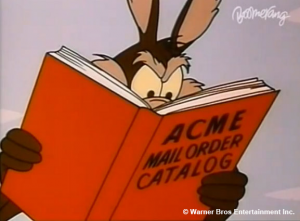Progress Scoring (Part 1) …“But…we don’t forecast that way!”

Like Wile E. Coyote, many companies forecast B2B order capture by using a “% Probability (sales opinion)” foundation, rather than designing a progress scoring system. Does this work? No it doesn’t and it generally produces forecast accuracy below 50%.
Just like the coyote, they use lame and archaic business processes, like contraptions that arrived by parcel delivery (from the ACME catalog, you’ll recall…).
These sales teams find a way to head toward the forecasting cliff, with justification statements like:
-We have always done it this way, or
-We did it that way with my previous employer, or
-The boss (CEO, Board, VP, etc) wants it that way
Danger zones are plentiful in Sales Management, and Forecasting based on gross Deal value is one of them – with or without % probability opinions. Without ranting any further, let me propose that an “Opportunity progress scoring system” is part of the answer. We’ll talk about how to design a custom scoring system for your B2B sales team, which provides a better tracking and planning foundation. This is something you can do in 4 steps:
1. Analysis – yes, you need to analyse current and past success/failure
2. Tool design
3. Process design
4. Scoring system design
Let’s get started.
Progress Scoring Part 1 – Analysis
Analyzing success/failure has two purposes – making plans for a better selling approach, and gaining acceptance of sales professionals that a change is necessary. The changes will involve new sales behaviors, something that some people will resist. Typically, we start with sales people who may be skeptical or downright suspicious, so ask about “stalled deals” – do you have any? How long have they been stalled? What do the customers say about why your proposal was not approved? Take notes and look for patterns. Perhaps there are common reasons why the customer could not prove the payback, or the urgency was not felt at the economic approval level.
Now the acid test for Sales people – to win those deals, and earn those commissions, are you willing to sell differently? Are you willing to try something new?
Analyse both “how we lose” and “how we win”. Then, list the conditions for success that you have decided will need to be created for each opportunity. (…. you will often get your best ideas from brainstorming “How do we avoid the loss reasons?”)
Thus you produce a list of the End Game winning conditions – and it may look something like:
– Strong definition of an important problem to be solved for the customer, using specific customer cases and language (…to get more decision-makers on board)
– Strong metrics of payback, or payback potential, for customer’s investment (…to get budget approval)
– Early acceptance by customer of a proposal to collaborate on defining our solution (…to get conversation leadership, while customer is receptive)
– Identification of specific reasons for urgency, and urgency confirmed by users, managers, and technical support (…to avoid stalled deals, and late-stage pestering of buyers)
Next, for each winning condition, recognize that specific actions by sales are needed to achieve each one – in some cases it is just necessary to ask a few different questions.
In other cases a convincing written sales tool will be needed, either a generic business case, for example, or a specific customized business case for each prospect. In the next section, we’ll move on to sales tool design.



Follow Us
Follow us on LinkedIn for updates.